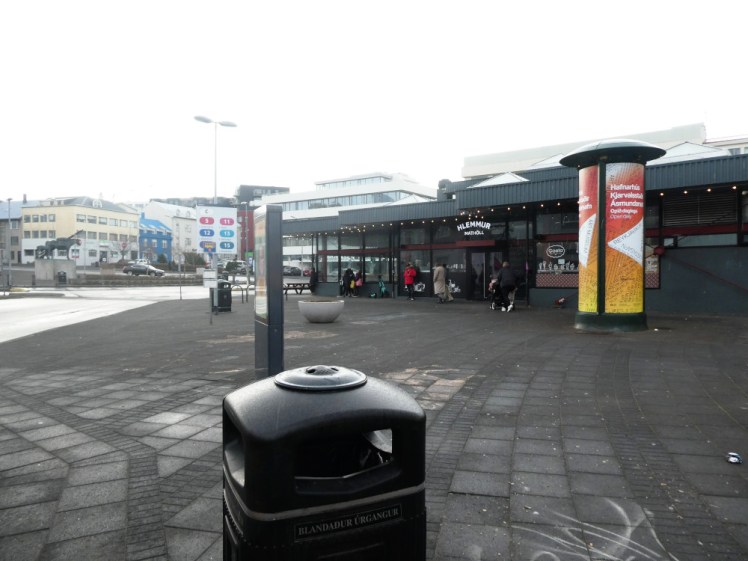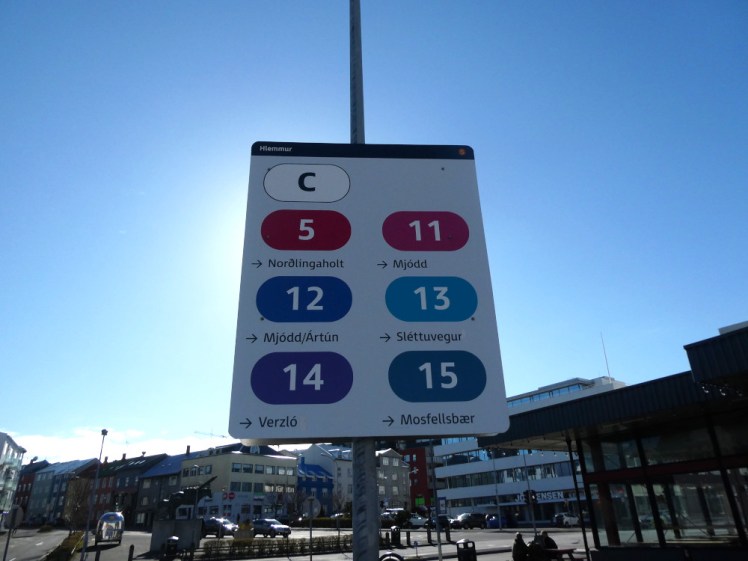There are so many ways to get around when you’re travelling but people seem to avoid public transport. It’s a bit intimidating – how does it work, where does it go, etc? – but it’s something I like to do, mostly because not everything is in easy walking distance and I personally don’t like taxis. So this post is about how to use public transport in Reykjavik.
Reykjavik public transport takes the form of yellow-orange single-decker buses. There’s no metro, no light rail, no trams, no trains. Tour buses take people long distances, although even those services have cut back to almost non-existence – the only long-distance buses running reliably these days are the Highland buses to Þórsmörk and Landmannalaugar. You either go on an actual tour or you hire a car. But in the Reykjavik area, there are buses and those can be useful.

How do I get a ticket?
You have two options. Number one is to drop the precise number of coins or notes in the plastic box when you board the bus. There’s no change. In 2024, a single ticket is 630kr. The driver will watch you do it but will make no movement or comment. I can’t even remember if you get a paper ticket for it.
What everyone does in real life is to use Klapp. Klapp is the ticketing system. You download the app and then you can either buy a travel pass or individual tickets. Individual tickets will display a QR code and you scan that on the panel when you board the bus. The locals hold their phone up to the driver, which I assume means they’re showing a pass of some kind.
Now, I have a problem here. I downloaded the app, I popped a single ticket in my basket and I went to pay for it and it rejected my card. Over and over again.

I moved to the desktop platform and tried there. Rejected. For what it’s worth, I had exactly the same problem booking the Sky Lagoon. In the latter case, I eventually borrowed my mum’s credit card out of desperation and that went through which makes me wonder if there’s an issue with Visa that doesn’t exist with Mastercard, so if you want to buy a ticket, try a Mastercard. The app works in English so you should have no problem navigating it. The tickets will sit in your app until you activate them by scanning them on the bus and then they’re valid for 75 minutes, so if you need to change bus in that time, you only need the one ticket.

I eventually had to buy a Klapp ten-ticket pass. You can get them from various shops and information places around Reykjavik but you can definitely get them at the 10-11 – there’s one opposite major bus hub Hlemmur and there’s another downtown near Lækjartorg which is the other major bus hub. They come with a bar code stuck to them so the shop can scan them and sell them but you have to peel it off to reveal the QR code underneath which you’ll scan ten times on the bus.
So yes, get on the bus and scan your QR code, either the one on your paper ticket or the one that pops up on your app when your ticket is activated.
How do I know which bus I want?
Google Maps is your friend. Find your nearest bus stop and the nearest bus stop to wherever you’re going and ask it for directions by public transport. Then check that against the timetables on the Strætó website and/or app. You’ll probably find a local bus map on the wall of the bus shelter and you can follow the colour-coded lines and make sure they’re going where you want to go.


The timetable by itself is… well, it’s fine if you know the name of the nearest bus stop. As usual, they’re not that intuitive. The bus stop for the Sky Lagoon is Hafnarbraut, the bus stop for Nautholsvik is HR and so on, so Google Maps will help a lot.
Where do I get the bus?
There are several hubs around Reykjavik. As I’ve already said, Hlemmur and Lækjartorg are the two you’re likely to encounter in downtown Reykjavik. Mjódd is the big travel interchange but it’s a good distance from the city centre and you’re only really likely to end up there if you’re changing for a bus into the countryside – they go to various destinations around the south and the west but often only once a day in each direction and never on the day you want to use them.

If you’re not around one of the hubs, ie each major end of Laugavegur, the main tourist thoroughfare, you’ll find bus stops of Hverfisgata, the non-pedestrianised road that runs more or less parallel to the west end, Snorragata which runs from Hlemmur down to the Ring Road and all around the BSI station. Look it up on your phone. But I’d make my way to Lækjartorg or Hlemmur myself.
How do I know where to get on the bus?
At the hubs, there will be various stops labelled with a huge sign and each route is a different colour. It’s pretty easy to figure out which stop you want, as long as you know the terminus of the bus you’re getting on. I was going to the Sky Lagoon so first I wanted a 4 or a 1 to Hamraborg. The 4 terminates at Hlemmur so getting on it in the wrong direction wasn’t possible which made things easier. The 4 heading to Mjódd was my only option. But when I reached Hamraborg, I wanted a 35 to Hafnarbraut. Again, this is easy enough as long as you know exactly which bus you want. The 35 goes along the peninsula, dropping you at Hafnarbraut three or four minutes in, and then back to Hamraborg via a huge circuit of the town. When I left the Sky Lagoon, I wanted the 36 which goes in the opposite direction, which had already done the huge circuit of town and was now heading back up the peninsula to Hamraborg. You can get on either as long as you’re willing to risk twenty minutes of unnecessary circuit time and I did take the 35 back on my second evening because the 36 had stopped running and it was one minute quicker to endure the long bus ride than to walk.

Let’s do a harder one. I took the bus from Hlemmur to the big pool at Laugardalslaug. That’s the 14. But Hlemmur is in the middle of its route. I needed the 14 heading to Verzló, not the 14 heading to Grandi. Getting back from the pool is easier; you just get the back on the bus from the opposite side of the road to the one you got off it on. But back at Hlemmur, you don’t have that obvious “which way is this bus going to go?” because they tend to circle Hlemmur before going off wherever they like. I had to find the big colourful sign saying “14 Verzló” and then make sure the 14 that stopped there said Verzló on the front.
Because that’s where I messed up on Monday. I wanted to take the 5 to Nautholsvik, down by the university and the domestic airport. The big colourful sign said 5: Norðlingaholt but the timetable fastened to the pole underneath said it was going to HR, which was the stop I wanted. So when the bus arrived with “5 Norðlingaholt” on the front, I didn’t question it. The timetable says it’s this stand. It wasn’t! I had to leap off at Ártún, which is another hub – a collection of bus stops on either side of the dual carriageway and a few more on the ordinary road underneath. Off at Ártún B, run down the steps, under the road and back up the other side to leap on the 5 at Ártún A to retrace my steps back to Hlemmur and beyond. Moral of the story: if the sign above the bus stop and the timetable on the stand don’t match, the thing to pay attention to is what’s written across the front of the bus!

Where do I get on the bus?
At the front door. Show the driver your app or ticket, scan your ticket or drop your coins in the box but you have to get on at the front. Get off by the middle or back door – the front door is mostly preoccupied with new passengers boarding. This isn’t like London; you can’t scan your pass on a random pole in the middle of the bus.
How do I know where to get off?
Bearing in mind that bus stops are not necessarily right outside the place you want to go to, you need to know the name of it. You worked that out earlier on, so you’re good. The majority of Reykjavik city buses have an electronic noticeboard which will tell you what the next stop is. Press the button when you see yours come up and jump off when the bus stops.

If it doesn’t, you can either keep Google Maps open and watch your location and be ready to ding or you can ask the driver. In my limited experience, bus drivers don’t speak as much English as I would expect from someone of their average age but the English-speaking ones are more than willing to yell down the bus that it’s your stop and with a little pantomime, you can get the non-English-speaking ones to understand that you’re lost and confused and they’ll do the same for you.
And I think that’s everything you need to know about how to use public transport in Reykjavik! If you have any more questions, leave me a comment and I’ll get back to you!